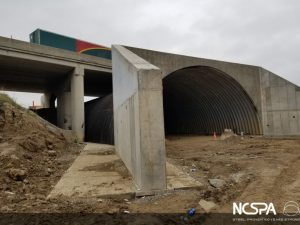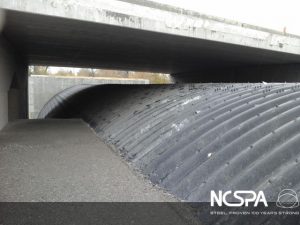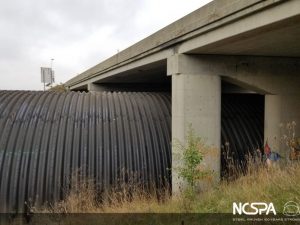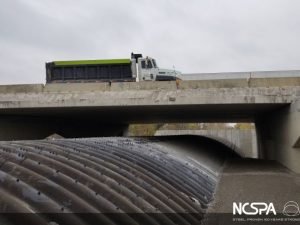By: Big R Bridge
Bridge No. HAN-075 -1713 carries I-75 traffic over an abandoned railroad bed north of the Blanchard River on the west side of Findlay, Ohio. The existing bridge was constructed in 1989, consisted of three spans totaling 140 ft and carried two lanes of traffic in each direction. The bridge was scheduled to be replaced along with several other bridges on the I-75 corridor through Findlay to add a travel lane in each direction.
-1713 carries I-75 traffic over an abandoned railroad bed north of the Blanchard River on the west side of Findlay, Ohio. The existing bridge was constructed in 1989, consisted of three spans totaling 140 ft and carried two lanes of traffic in each direction. The bridge was scheduled to be replaced along with several other bridges on the I-75 corridor through Findlay to add a travel lane in each direction.
Factors considered when evaluating bridge replacement options included service life, resilience, maintenance costs, staged construction, structural capacity, and hydraulic capacity, among others. The area of the project is relatively flat and prone to flooding. I-75 is constructed on high ground and the abandoned railroad bed below the bridge provided a conduit for relief when flooding occurs. It was important to maintain this condition with the replacement bridge. It was important to minimize traffic disruptions during construction, so a phased approach was needed for the new bridge. Deicing salts are frequently used on the roadway and considerations needed to be made during design to ensure minimum service life requirements were met. I-75 is a major freight corridor extending from the Canadian border at the Upper Peninsula of Michigan to Miami, Florida and there was a desire for the new bridge to accommodate current and future truck loading requirements. Bridge inspection and maintenance costs are a financial challenge for all state DOTs and it was important that the new bridge provide a simple and economic solution.
The 41 ft span x 21’1″ span deep corrugated galvanized steel buried bridge provided by Big R Bridge met all of the design, performance, hydraulic, maintenance, and overall cost requirements. The buried bridge was sized to meet the site hydraulic requirements and fit below the existing bridge to provide an accelerated bridge construction (ABC) solution and allow for staged construction. A portion of the structure was constructed adjacent to the existing bridge and then pulled into place below the bridge. The remaining portions of the buried bridge were constructed in place. After construction of head walls at both ends of the structure, the structure was backfilled in stages as I-75 traffic lanes were moved to travel over the buried bridge to accommodate removal of the exist bridge. The Ohio DOT opted to apply an asphalt coating to the exterior of the structure to provide secondary protection from deicing salts. The structure was easily able to accommodate the HL93 design loading by taking advantage of the benefits of soil-structure interaction, with reserve capacity for increased future loading. Elimination of the the bridge deck, approach slabs, and all other features associated with traditional bridge spans and decks significantly reduced inspection and maintenance costs. Future maintenance will consist of typical maintenance associated with the roadway and removal of unwanted vegetation below the structure, resulting in significant long term savings. This was the largest span deep corrugated buried bridge replacement below an interstate highway in the United States and the first such structure designed and specified by the Ohio DOT.

